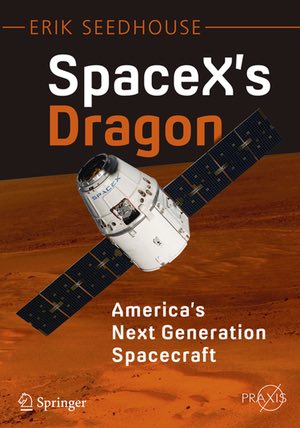Review: SpaceX’s Dragonby Jeff Foust
|
| Dragon is, in many respects, no less important to SpaceX than its launch vehicles. |
As with its current CRS contract, SpaceX offered to use its Dragon spacecraft for CRS-2; the new contract will include the option of having the spacecraft actively dock with the station rather than be grappled and berthed by the station’s robotic arm, as it is today. The cargo Dragon will be similar to the crew version of Dragon SpaceX is actively developing; the NASA document noted that one reason for SpaceX’s higher price was in part because of “two separate vehicles with separate production lines.”
While much of the attention SpaceX has received, particularly recently, focused on its launch vehicles and efforts to make them reusable, Dragon is, in many respects, no less important to SpaceX. Space Act Agreements and later contracts with NASA, first for cargo and later for crew, provided SpaceX with significant financial and technical support to develop Dragon, not to mention a large anchor customer. And Dragon, particularly its crewed version, will be important for SpaceX, and founder Elon Musk’s, ambitions to make humanity multiplanetary.
Given that important role Dragon plays, its development is worthy of a book. Unfortunately, it probably deserves a better book than SpaceX’s Dragon: America’s Next Generation Spacecraft. Erik Seedhouse offers a history of Dragon’s development for cargo and crew missions, and its potential future on missions to Mars, but there’s very little insight about Dragon beyond what’s already publicly available, and even that information is sometimes wrong.
Seedhouse takes the reader through an introduction to SpaceX and then NASA’s commercial crew program, before going back to Dragon itself and its development for NASA’s earlier commercial cargo program. He provides summaries of all of the Dragon missions to date (including a brief discussion of the Falcon 9 launch failure on its seventh CRS mission last June), then discusses commercial crew development and potential future uses of Dragon, including missions to Mars.
Those discussions rely very heavily on publicly available information, without much additional insight. Some of the discussions of CRS missions to the station read like Wikipedia entries, with lots of technical information, but little else beyond a quote or two from NASA or SpaceX officials. There are, for example, no behind-the-scenes accounts of the development of Dragon or its missions. (Seedhouse at one point refers to an unnamed “colleague” who works at SpaceX, but the only insider info that person offers is that “Elon Musk could be a very difficult boss to work for,” hardly a novel assessment.)
| He devotes an entire chapter to SpaceX’s proposed DragonLab free-flyer missions, but only in the chapter’s final paragraph addresses its biggest question: when, if ever, those long-delayed missions will fly. |
This creates some missed opportunities. For example, on SpaceX’s second CRS mission in early 2013, the Dragon went out of control shortly after reaching orbit, resulting in hours of drama and fears the mission would be lost until ground controllers were able to correct the problem with a thruster valve. That incident, arguably the biggest in-flight problem that Dragon has experienced to date, is covered in just one paragraph in the book.
Coupled with that limited insight are errors or other unusual observations. The first Dragon mission to the ISS, known as COTS 2/3 or COTS 2+, is mentioned a couple times in the text as CRS 2/3. A photo of that launch in the book shows a Falcon 9 lifting off in daytime, but that mission in fact launched in the pre-dawn hours. On the commercial crew side, he suggests SpaceX’s Crew Dragon and Boeing’s CST-100 Starliner will allow the station’s partners to increase the crew size to 14. NASA is instead considering increasing the crew only by one, to seven people; it’s unlikely the station in its current form could comfortably accommodate 14 people for extended periods. He also devotes an entire chapter to SpaceX’s proposed DragonLab free-flyer missions, but only in the chapter’s final paragraph addresses the biggest question about DragonLab: when, if ever, those long-delayed missions will fly.
In the book’s final chapter, Seedhouse speculates about Dragon’s future, including missions to Mars. Here he is, ironically, on firmer ground, simply because SpaceX has disclosed few details about those plans (Musk recently said he would finally lay out those plans in greater detail this September at the International Astronautical Congress in Mexico.) SpaceX’s Dragon: America’s Next Generation Spacecraft tells a story about the development and future possibilities of Dragon, but it’s clear there are more Dragon tales to be told.
